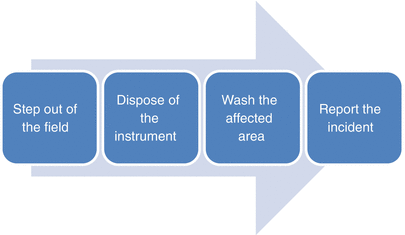Exposure to a larger quantity of blood or other infectious fluid
Prolonged or extensive exposure of non-intact skin or mucous membrane to blood or other infectious fluid or concentrated virus in a laboratory setting
Exposure to the blood of a patient in an advanced disease stage or with a high viral load
A deep percutaneous injury
An injury with a hollow-bore, blood-filled needle
What Do I Do in the Event of an Occupational Exposure (Fig. 1.1)?
Any employee who receives a stick during a surgical procedure should step out of the field and avoid further contact with the patient to prevent potential transfer of blood-borne pathogen from healthcare worker to patient.
Dispose of the instrument that has punctured the skin (i.e., suture needle, syringe) rather than reintroducing it to the patient.
Those with a needle stick should wash the affected area thoroughly with soap and water as quickly as possible after the exposure [13].
It is not necessary to use alcohol or other caustic agents such as bleach to clean the affected area.
The practice to “milk out” more blood is controversial and not recommended by the Centers for Disease Control (CDC).
Irrigate splashes to the eyes or mouth with water or saline as quickly as possible after the exposure. Do not use caustic agents such as antiseptics or disinfectants.
Report the exposure immediately [12].
How Do I Report the Incident (Table 1.2)?
If the source patient is known then the patient should be tested for HIV/HBV/HCV (pending informed consent).
The CDC recommends that if the source patient cannot be tested then the medical diagnoses, clinical symptoms, and history of risky behaviors should contribute to the decision regarding post-exposure prophylaxis (PEP) [12].
When the source patient is not known then the likelihood of high risk exposure must be evaluated and used to guide further action (i.e., community infection rate, demographics of patients seen at site, etc.).
It is not recommended to test the discarded needles for bloodborne pathogens since the reliability of testing is unknown.
Baseline testing of healthcare practitioners should be performed for all occupational exposures.
Those exposed to HIV should receive repeat HIV-antibody testing at 6, 12, and 24 weeks following exposure [14].
Those exposed to HCV should have repeat tests for anti-HCV IgG and liver enzyme (ALT) at least 4–6 months after exposure.
Table 1.2
Necessary information when reporting an occupational exposure
Details of the incident (type of bodily substance involved, the route of exposure, the severity of exposure, time exposure occurred, etc.) |
Details of the exposure source, if known (e.g., source material or patient HIV/HBV/HCV positivity) |
Details of the exposed healthcare provider’s history (e.g., vaccination status, pregnancy status, medical conditions, etc.) |
Should I Take Post-Exposure Prophylaxis (PEP)?
HIV
The recommendation to initiate antiretroviral prophylaxis is determined by the factors noted above, in addition to balancing the risk of HIV with the known risks of PEP medications [15].
PEP rapidly loses its effectiveness if delayed. The goal should be to swallow the first pill within the first 24–36 h after exposure. Some reports note that if it is started more than 72 h after exposure then it is not effective [16].
Stay updated, free articles. Join our Telegram channel

Full access? Get Clinical Tree









